#rise of china as a superpower
Text
China’s economy is currently on the operating table, hunched over by surgeons, chest cavity splayed open, hooked up to a cardiopulmonary machine, surrounded by nurses staring at monitors flashing vital signs. It all looks rather grim.
This surgery, however, is not an emergency bypass. That would be too easy. China has had many of those already – stimulus packages, grand infrastructure projects and many rounds of directed lending.
Every two decades or so, going all the way back to the founding of the PRC in 1949, the surgeons get ambitious. These guys are mad scientists attempting a comic book trope – to create the ultimate superhero.
They want to inject super serum, replace skeletal calcium with adamantium and dose the patient with gamma rays, giving China the powers of shazams out the wazoo.[...]
In the lamented “pre-reform” era, China’s mad scientists engineered spectacular growth by increasing investment from a prewar 6% of GDP to 20% in the first Five-Year Plan, covering 1952-1957. This led industrial output to register a compound annual growth rate.
The Great Leap Forward accelerated this growth to 66% in 1958 and 39% in 1959 before crashing and burning in 1961 when mismanagement of communal farms and “backyard blast furnaces” caught up with the mad scientists.
Course correction starting in 1962 recovered all lost ground by 1965. According to economist Cheng Chu-Yuan, China’s GDP growth averaged 11% between 1952 and 1966, the eve of the Cultural Revolution. (T. C. Liu of Cornell and K. C. Yeh of the Rand Corporation have a lower estimate: 8%.)
More importantly, China built a full kit of infrastructure, machinery and equipment capable of driving future industrialization.[...]
Many analysts have a tabula rasa understanding of China’s reform era, as if there had been no economy before Deng Xiaoping. In reality, China’s industrialization started right after the formation of the PRC with some of the fastest growth recorded in the 1950’s and 1960’s. Even during the “low growth” Cultural Revolution, resources directed towards public health (for example, barefoot doctors) and primary education doubled life expectancy and quadrupled adult literacy by 1980 from pre-PRC levels.
The mad scientists are now at it again. They have about twenty years of new data not just on China but from the rest of the world. When Zhu Rongji was head surgeon, history had ended and markets reigned supreme. This time around, the surgeons are correcting for market irrationality and negative externalities. The next twenty years is again being determined on the operating table.
Three years ago, the surgeons pried open China’s chest cavity with the three red lines credit limits, instantly seizing the speculation driven property sector. Since then, they ripped out unnecessary organs like education companies, clamped the Ant Financial artery and eviscerated the video game industry.
All of this has caused spasms in vital signs from lackluster growth to rising youth unemployment. Wondering whether China will or will not stimulate the economy next quarter or next year is missing the forest from the trees. For the next few years, China’s economy will still be under the knife and whatever adjustments will merely be anesthesiologists and technicians nominally dialing the drugs up and down and adjusting the heart-lung machine to maintain vital signs.
What are these mad scientists trying to achieve? We believe President Xi Jinping’s 2020 target of doubling China’s GDP by 2035 stands. That is an average growth rate of 4.7% for 15 years. But beyond just a numerical target, it is important to figure out what superpowers China is trying to acquire. And just as importantly, what Kryptonite factors China is attempting to inoculate itself against.
China wants America’s Silicon Valley, but regulated; Japan’s car companies, but electrified; Germany’s Mittelstand, but scalable; and Korea’s chaebol conglomerates, but without political capture. It wants to lead the world in science and technology, but without cram schools. A thriving economy, but with common prosperity. Industry, without air pollution. Digital lifestyle, without gaming addiction. Material plenty, without hedonism. Modernity, without its ills. This is, of course, a wish-list and unrealistically ambitious. But these mad scientists sure as hell are going to try. They’ve developed a taste for it.
In college, early into the semester, we went through a ritual called course exchange. Students gathered in an auditorium to swap classes after sampling lectures for three weeks – satisfaction was not guaranteed. The strategy passed down to underclassmen applied to both course exchange and significant others: “Add before you drop.”
China is undergoing – but perhaps botching – the same process with a more party-esque slogan, “Establish the new before abolishing the old.”
The surgeons have been on a tear gutting the old. The big kahuna is, of course, the property sector. But right behind are platform monopolies, private education, financial services and video games. The new has been playing catch-up, with 5G equipment, electric vehicles, photovoltaics and wind turbines being leading examples.
From all appearances, the Industrial Party is in ascendance and China will double down on climbing the manufacturing value chain. The Industrial Party is a political identity that believes industry, science and technology should determine China’s future. Adherents believe that China’s strength lie in the technical skills of her population and thus favor hard-science, high-tech industries as opposed to services and business model innovations.
Therefore, Chinese politicians, whatever their predisposition, must find a way to create space for this next generation of scientists and technicians to develop themselves. They cannot be confined to a production line at a Foxconn plant. Maintaining social stability means finding a use for future scientists and technicians, which means pursuing industrialization. Is there any other way? The key variable for determining the course of China’s future development is thus the massive number of talented technical and scientific workers.
If mistakes were made, it would have been in sequencing and in faith – dropping before adding is a poor strategy in both love and course exchange. China’s mad scientists may have been too confident that electric vehicles and renewable energy would be followed quickly by semiconductors, pharmaceuticals and commercial aircraft.
Perhaps they have reason to be confident. Planning for this surgery has been in the works since 2015 with the Made in China 2025 project. China has been steadily eroding imports of high value added intermediary goods like batteries, precision parts and electrical components, flipping trade with South Korea from deficit to surplus.[...]
China never properly transitioned from its Soviet era Material Product System (MPS) of national accounts to the United Nation’s System of National Accounts (UNSNA) standard, leaving out much of services from reported GDP.
We calculate that China accounts for 22-24% of global GDP and 20-23% of global consumption. We also calculate that household consumption is 50-55% of China’s GDP, in line with global averages. China should easily be able to grow at 4.7% through 2035 with only a modest increase in consumption’s GDP share (5 percentage points over 10 years) without upsetting global economic balances.
In the reform period prior to Xi, everything was sacrificed at the altar of economic growth. In the new era, growth has been walked down from 9.6% in 2011 to an average of 4.7% in the Covid years (2020-2023) as an increasing litany of issues were given precedence. Debt however, soared over this time from 175% of GDP to over 300%. What exactly did all that debt buy?
When Xi assumed leadership of China, he declared that inequality could not be allowed to increase further. Inequality is perhaps the major Kryptonite factor of the American economy which China wasted no time in matching as the economy roared with market reforms.
While still problematic, inequality, as measured by the Gini coefficient, has steadily fallen since 2010 largely as a result of massive investment in urbanization, pushing people into cities and pushing cities up the tiering ladder.[...]
China also poured resources into stamping out last-mile poverty. While most poverty alleviation in China was through economic growth, recalcitrant extremely poverty could only be eradicated by concentrated marshaling of resources, from relocating entire villages to weekly visits by social workers.[...]
Since peaking in 2012, air pollution in Beijing has been cut by over 60%, with Shanghai falling over 50%. China, which used to dominate the list of most polluted cities, now only claims one spot in the top 20. None of this came cheap, from installing scrubbers in smoke stacks to increasing renewables to moving heavy industry to strict emissions regulations for cars.[...]
Before Hu Jintao handed the reins to Xi, Hu warned delegates to the 18th Party Congress in 2012 that “[corruption] could prove fatal to the party… and [cause] the fall of the state.” The popular opinion in the West is that Xi ended China’s highly successful reform era because of an ideological bent. This is off the mark. Xi was brought in to clean house as the wheels were coming off from excesses of the reform era.
Throughout Xi’s decade in office, there has been no letup in his anti-corruption campaign. In 2022, a record 638,000 officials were punished for corruption. While there haven’t been any large scale ideological appeals to the public, it’s a different story within the 98-million-member party.
During this time, free market capitalism and liberal democracies also faced their own existential tests. Success or failure going forward will depend on whether liberal institutions remain intact in the West and whether party discipline can be maintained in China.
What the PRC has had since 1949 is a governing party with the political autonomy to play mad scientist. [...]
Of course we live in the real world, not a comic-book world. The question in the real world has always been whether the economy can be engineered by mad scientists from the top down or is it best left to the invisible hand of the market? [...]
The standard economic opinion – against all evidence – is that China was economically stagnant before Deng’s market reforms. The thinking on this for the American economys is undergoing a transformation in egghead land – just how has neoliberal economics benefitted the American people over the past few decades?
In a Q&A exchange at a conference in Malaysia, Eric Li, the barbed-tongued venture capitalist, was asked, “Do you think top-down directives are sustainable in the long run?”
To which he replied, “It’s the only thing that’s sustainable.… That’s why America is failing today.” After World War II, Li said, the Americans “lost the ability to do top-down design.”
Dec 2023
99 notes
·
View notes
Text
Ok so I watched rise of the titans and it was... An experience...
The things I loved/liked:
Children of the sun summoning the amulet sequence. It was pretty cool. But it's funny this is one of the things in this category since it was basically ripped straight out of the scene in 1x12. But I don't mind a little self plagiarism if it's satisfying
Toby actually being smart and having a part in the defeat of bellroc
Toby's last moments with Jim. Not to say I liked Toby dying that was fucking horrible but seeing Toby and Jim be close again was something that had been desperately absent for a few seasons. And the idea that Jim even after winning would sacrifice the entire world and take on the burden of going back into the past himself, just to save Toby is kinda sweet even if this movie didn't go in that direction. Cuz it just proves this boy would give up anything for his friends and that's one of his core qualities and why we all love him
The opening sequence on the subway. That was pretty excellent and raised the hype and allowed everyone an equal chance to shine
Aarrrgghh going batshit when Toby dies cuz mood
The taco truck with the little tune entering arcadia and all the government are like 'remove the barricades, let them through!!'
Jlaire was pretty cute in this movie, not the best it's ever been but y'know.
Douxie was pretty good throughout
The things I was ok/unsure about:
Ajas characterisation. I know a lot of people hated it in this movie but it wasn't the worst. She acted like a leader trying to protect two worlds of people, and that's entirely fair tbh. I didn't like how she doubted Jim but as she didn't know him that well especially as neither of them remember the events of d'aja vu it was kinda understandable. And I agreed that they did need a contingency evacuation plan
Krel. He was consistently good in this movie as usual but didn't get enough time to shine individually, same goes for blinky and aarrrgghh
Stricklake getting married was cute, however I didn't like how Barbara was used as a mouthpiece to mediate all of Jim's relationships with the older men in his life, i.e. when her and Jim talked it was either about strickler or James SR. and honestly that's just a disservice to Barbara's own character (and makes me realize that I doubt this movie passes the bechdel test)
The things I disliked:
Eli basically doing nothing all movie and being useless
Having Eli come back after a glow up for the sole purpose of having a moment where Steve is jealous and distrusting of his girlfriend. Actually no this can go in the hate category too ❤️
Jim saying 'i always wondered about dad' to his mom. The only reason this isn't in the hate category is bc it meant we actually spent time on the relationship between Jim and Barbara which is something that was sorely lacking in wizards tbh, and something that really made trollhunters shine. But what happened to 1x17's 'you know I don't care about my father'? Like what is this bfr
Toby being used as comic relief didn't bother me in this as much as in wizards cuz at least he got that important moment at the end but him saying 'moral support is the lamest superpower' what happened to the Toby that cherished supporting his friends and knew that his support was the greatest gift he could give to Jim and Claire just as their support was his greatest gift. Cuz that seemed like a key factor in earlier seasons imo. Also what happened to the Toby that started becoming confident in his abilities in earlier seasons of trollhunters?
The blatant Hollywood stereotyping. The kids kicking the football in Brazil and the fishermen in the South China sea, and then the bright neon lights of anywhere in east Asia at nighttime visual. It's not the worst but I'm tired tbh
The things that I absolutely fucking hated:
This shouldn't matter to me so much, but why when Jim went back into the past, did he wake up at 8.00 instead of 6.00? You could claim it was because it was cuz he was disoriented, but the time of his alarm should never have changed. If I remember that it said 6.00 on the alarm, and I haven't watched the first episode since probably 2018, the screenwriters should've too. It's just lazy. Or maybe it's symbolic of the fact that Jim only used to wake up at 6.00 to make his mom breakfast and all of them lunch, something which was a key part of his characterisation and clearly showed how much he cared for and loved the people around him - something which is very obviously no longer a part of his character since he allowed Steve to bully Eli and manipulated Toby into becoming the trollhunter. But idk. You choose
Nomura's characterisation?? First of all she just seemed ooc, like a stereotype version of herself for some reason. Secondly, her death. She died. In the sun. She's a changeling. The sloppiness of the writing team in keeping their facts straight is fucking astounding.
Stricklers death. Just for shock value and a play on emotions cuz it contributed nothing to the story. Same with nomuras. All it showed me is that the writing team were sitting around a table and someone goes 'you know we should kill off a few characters early on in the movie just to show this is a serious level threat'.
Pregnancy being used as a fucking joke. I wouldn't have necessarily minded the mpreg concept happening but the execution was just. Ugh. Steve being pregnant was treated as a joke and gross and just something to fill in time as comic relief, rather than what pregnancy actually is which is fucking hard work. It just seems like another extended misogyny-as-comic-relief trope again and Steve's character and everything was thrown down the drain
Toby Jim and Claire not having a group moment together. There was a scene somewhere in the movie where Claire was comforting Jim and I was wishing Toby was there too. If they're going to play the moral support joke with him at least have him be there when morals are at the lowest
Toby being stuck to the van. The treatment of his character in general throughout the last half of the franchise, he should've been given proper development as a character since trollhunters ended but fuck that I guess
Getting human Jim back was WASTED. Utterly wasted on this poor excuse for a movie. The peak of Jim's character arc was accepting himself in every form even when his humanity was stolen from him. The 'am I a hero without the amulet' in this and even the corruption storyline in wizards were both forced, particularly the former, as we'd already gone through that part of his arc in s2 (and it was one of the best arcs this franchise has produced frankly). It was really really apparent they couldn't think of anywhere to go with his character but still wanted to use him bc he remained the most popular. Fanfiction writers can and have done better. Fuck this movie
The lack of emotional maturity and depth between a lot of the characters honestly?? I really don't know how to explain this other than anytime this movie paused to have an emotional conversation or moment between two characters it seemed hollow and worthless because none of them were going through true important character arcs
I'm sure I have more things in this category but for now this is all I can think of. Might rb later with more if I can think of more things that really annoyed me :)) time to rewatch trollhunters s1 and remember how good this franchise used to be :))
#trollhunters#toa#tales of arcadia#jim lake jr#3 below#3below#wizards#trollhunters rise of the titans#rise of the titans#toby domzalski#claire nuñez#aja tarron#krel tarron#douxie casperan
265 notes
·
View notes
Text
Of the 7.5 billion people on the planet, only 15 million are #Jews – Jews make up a miniscule 1/5 of 1% of the world’s population. Literally 99.998% of all people are not Jews.
#Israel, the world’s only #Jewish state, accounts for a mere .01% of the Earth’s total land area. So, literally 99.99% of the world’s land is not Israel.
Yet recent data tracking traditional media attention paid to all countries shows Israel absurdly gets the 6th most attention, the majority of which is negative coverage of the Jewish state.
Add the words “#WestBank” & “#Gaza” to the mix, and that number rises to 3rd overall behind only the #UnitedStates & #China – two world superpowers with a combined population of nearly two billion.
When it comes to theories, controversies, opinions, & condemnations, the topic of "Israel" punches outlandishly above its weight in today’s highly partisan, tribalistic, “bubble vs. bubble” political brawls.
Captain Allen
39 notes
·
View notes
Text
Worldbuilding masterpost: The International 2030

The Worldbuilding projeckt "International" is not an alternate history, I would concider it fiction, as it lacks a clear point of departure.
The worldbuilding starts during the russian revolution, were oposed to the Bolsheviks taking power, the First Congress of the Soviets was formed and dominated by the democratic socialist PS, who with the help of ukranian anarchist groups ousted the authoratarian SRP (Socialist Revolutionary Party).
The first political iteration of "The International" was formed in the interwar years by the Soviet Union to support and influence socialist movements abroad.
In the year 2030, 108 years after the founding of "The International", the now federal union spreads over large parts of Asia, Africa and Europa.
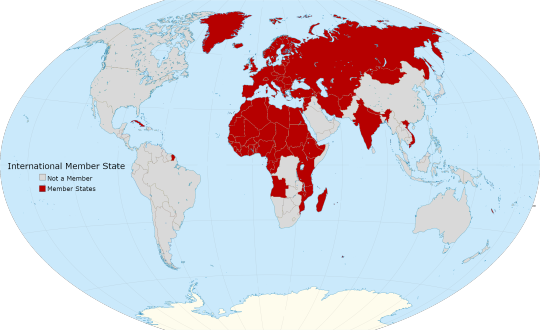
The situation around the world is a lot diferent. Ever since the Revolutions of 1989, the USA has worked to maintain and strengthen its influence in the Americas and in southeast Asia. Over the past two decades, China has ended its Maoist isolation and become a rising star, threatening the postiton of the two superpowers.
The International voted to federalise in the year 2000 during the Cairo Conference. Since then it has been focused more on its internal reorganisation than spreading socialism further, to great internal debate.
The International operates on the grounding principles of Democratic Socialism. Meaning in practice, political decisions are made through direct and representative democracy, whilst the means of poduction are owned by the workers, through a worker cooperative system.
The United States has fallen into an Authoratarien sham Democracy, undergoing a largescale reactionary backslide.
China has left its maoist emposed autarky and is the rising star of the superpowers.
Curent Crises:
The Mexican Emergency
The Congolese Civil War
The North American Refugee Crisis
The Venezuelan Insurgency
The Iraqi Civil War
The rise of Islamic Radicalism
The Rise of Christian Terrorism in Europa
The Taiwan Dispute
And smaller ones not listed here.
If you have questions, want clarification or are just interested into a specific part of the worldbuilding, my asks are open.
10 notes
·
View notes
Note
So we all know Communism works "in theory" but why does it never work in practice?
Most communist regimes are poisoned very shortly after they rise, because their leaders (Lenin and Zedong most notoriously) pass laws stating that only the Communist Party can rule so that the elite can't undo their work.
One Party States are the express-way to tyranny, so when Lenin died and Stalin took over, nothing really stopped him from doing insane bullshit and that's how the Soviet Union became a capitalist oligarchy overnight. And frankly, Lenin wasn't all that okay in the head in the first fucking place.
Things went fine in Communist china for like A MINUTE before Zedong got it into his head that China had to rival Britain as a superpower and then overworked/starved his own people to death to do it.
There's also just the fact that a lot of communists are more fixated on making communism work, than achieving the goals communism is supposed to achieve. A lot of communists in the past and present have largely opposed things like Social Democracy, Social Liberalism, and increased welfare because they make Capitalism more tolerable for the people, and in their view: If the people aren't suffering, they won't support a revolution.
When Communists say shit like that, it's the sign they've missed the point of why they're doing this in the first place.
For Communism to work, Communists need to start loving the people more than they hate the elite.
41 notes
·
View notes
Text
The next test of whether top U.S. adversaries can erode its role as the leading global superpower will come in the form of a major diplomatic confab in South Africa.
Next week, leaders of the so-called BRICS group—Brazil, Russia, India, China, and South Africa—will convene in Johannesburg for a major summit, where Moscow and Beijing aim to solidify a counterbalance to the Western-led international system. Both Russia and China are keen to breathe new life into the BRICS bloc to show the world that there are alternatives to the patchwork U.S.-led alliances and institutions that have dominated global affairs for decades.
There’s clearly a growing appetite among other countries for an alternative to the U.S.-led system: Some 40 countries, from Argentina to Saudi Arabia to Kazakhstan, have voiced interest in joining BRICS, while more than 67 world leaders and dignitaries were invited to next week’s summit.
“The global south will be watching next week’s BRICS summit closely in the hopes that the rising grouping of global and middle powers makes some progress in filling the considerable gaps left by America’s shoddy global governance,” said Sarang Shidore, director of the global south program at the Quincy Institute think tank. Even as emerging-market economies reel from the shocks of the pandemic and Russia’s war in Ukraine, Washington has offered little support, instead pursuing an aggressive campaign of interest rate hikes that has exacerbated economic turmoil around the world.
Next week’s summit harkens back to the days of the Bandung Conference, where 29 governments from Asia, Africa, and the Middle East assembled during the Cold War and laid the groundwork for the nonaligned movement. Like then, BRICS serves as an alternative, if inchoate, effort to push back against the hegemon of the day—albeit one that has been complicated by China’s and Russia’s membership.
“BRICS has tapped into a demand that wasn’t being met elsewhere,” said Rebecca Ray, a senior researcher at the Boston University Global Development Policy Center, who noted that countries that aren’t even applying for membership are attending the summit in Johannesburg. “The question is: What do they want their role to be in responding to that?”
There’s no clear answer yet. And experts don’t expect one to emerge from the upcoming summit, with few details yet released on the agenda or real deliverables. Complicating the matter is the fact that BRICS countries have vastly disparate national interests, and vague proposals to expand the bloc’s membership and economic influence seem poised to stumble out of the gate.
India and China are at loggerheads; South Africa is caught between a diplomatic rock and a hard place over its ties to Russia amid the war in Ukraine; and Brazil has done little to stick its neck out for Russia, despite its historically nonaligned foreign policy. All BRICS countries, even China, face economic headwinds that make any future plans to challenge the U.S.-led Group of 7’s spot at the top of the global economy more pipe dream than reality.
The grouping is currently in a “sweet spot, where it’s fulfilling its role, it helps members constrain the United States to some extent, [and] it strengthens ties between the BRICS,” said Oliver Stuenkel, a professor at the School of International Relations at Brazil’s Fundação Getulio Vargas. “But I think if there’s more ambitious projects, then it will inevitably strain this grouping and expose the divergences.”
For Russia, the BRICS summit is an opportunity to demonstrate that it no longer needs the West following Western efforts to isolate Moscow on the world stage in the wake of its bloody war in Ukraine. But that opportunity comes with an awkward footnote: Russian President Vladimir Putin is no longer attending in person as he has a warrant out for his arrest over war crimes in Ukraine from the International Criminal Court (ICC). South Africa, as a member of the ICC, would have been legally obligated to honor the arrest warrant.
China, meanwhile, is keen to position itself as the de facto leader of the global south and the friend of choice to countries worldwide that feel they have been undervalued or left behind by Washington and its most powerful and wealthy allies in Europe and Asia. Beijing has long pushed for the grouping’s enlargement, even though its ambitions have sparked pushback from other BRICS members.
“China is the only country that is not concerned at all about diluting the prestige of BRICS” by expanding it to more countries, Stuenkel said. “For China, I think it really makes sense to expand so that the BRICS can become an element in a more China-centric order—a Chinese-led system of different structures like the One Belt, One Road; the Asian Infrastructure Investment Bank; [and the] BRICS bank,” he said, referring to China’s leading global infrastructure investment program, the Chinese-backed multilateral lender, and the nascent New Development Bank established by BRICS countries just under a decade ago.
Yet Beijing has had a harder time getting the other BRICS members on board, further underscoring their competing visions of the group’s future. The idea of expansion has worried India and Brazil in particular, both of which have taken pride in the group’s exclusivity and fear that an open door will diminish its prestige.
“Brazil is very proud of its BRICS membership,” Stuenkel said. “If you’re part of a very exclusive club, it makes sense that you don’t want to see the club becoming open to everyone.”
One major proposal some leaders have floated ahead of the summit is developing a BRICS common currency to hedge against the U.S. dollar, although it is not on the summit’s agenda and experts are highly skeptical of the plan. Economist Jim O’Neill, who first coined the BRICS term in 2001, blasted the idea of a BRICS currency as “ridiculous” and “absurd” earlier this week.
“The idea that five countries with very divergent interests and trajectories can somehow form a coherent enough union to expand its membership and stand up this hare-brained idea of a BRICS currency seems really far-fetched to me,” said J. Peter Pham, a former U.S. diplomatic envoy to African regions during the Trump administration. “I don’t expect anything of substance to come out of this summit, unless you consider the lack of substance as itself politically substantive.”
Still, even without a common currency, Beijing has capitalized on the BRICS grouping to boost its long-standing bid to internationalize the renminbi and slash its dependence on the dollar. In the run-up to the BRICS summit, a growing number of countries, including Brazil and Argentina, have used the renminbi in trade to cope with a shortage of dollars and curry favor with Beijing. These efforts are set to continue long after Johannesburg, with BRICS countries expected to deliberate how to ramp up the use of local currencies in trade at the summit. They are also set to discuss a potential common payments system and committee focused on a joint currency—although experts don’t expect any challenges to the existing global financial architecture.
Talk of a BRICS common currency is “really a reflection of a desire among some segments of the world to have some counterweight to the U.S., the U.S. economy, the dollar,” said Daniel McDowell, an expert in international political economy at Syracuse University. But “I think most of this is just in fantasy land, because I don’t see any world in which it is really going to emerge in the way some people might hope.”
4 notes
·
View notes
Note
You mentioned a lack of antisemitism in China, so I’m curious what you think of China’s work to bring peace to the Middle East. Obviously the country has a lot of issues, including what appears to be pretty awful Islamophobia and of course authoritarianism, but I feel like the way people talk about it is similar to how people talk about Israel, where they claim to just hate the country and not its associated people but they clearly hate the people too, and they won’t appreciate any good the country does. Not to mention the more conservative people will see China as a threat to American exceptionalism, which is stupid. So I’m making it a point to be at least somewhat positive about China.
China’s had some good luck thus far with some other Arab countries so I’m optimistic. I’ve heard they have a pretty good relationship with Israel and Palestine, so we’re off to a good start. My only concern is I heard during the most recent rocket fire China told Israel to remain calm and not retaliate, which is pretty unreasonable
I'm sure there's some antisemitism in China, with people reading Protocols and spreading conspiracy theories about Jewish wealth and such, and also Communism being an inherently antisemitic philosophy - but all of that would be relatively recent and, as mentioned, not rising anywhere near the kill-your-neighbor level so common in other societies. And yes, there needs to be some tightrope-walking when discussing China's policies - it's a gigantic rich superpower that is economically and militarily pushing around its much smaller weaker neighbors for land and sea territory, while at the same time conversations from Westerners are often tinged with xenophobia and racism against ethnic Chinese people.
China helped broker the re-normalization deal between Saudi Arabia and Iran, but it remains to be seen whether that will actually be a help to peace. If they can in any way encourage Iran to stop funding genocidal proxy militias in Yemen, Gaza, and Lebanon, that would be a huge advance and I would be lastingly grateful. If this only amounts to reopening two embassies, then I am unimpressed. As Iran is now, anything that isolates them is good and anything that rewards them is bad. China would need to have a much clearer understanding of Middle Eastern motives and priorities than the USA, UK, USSR, and UN ever did in their own attempts. Are they that exceptional?
8 notes
·
View notes
Text
The 80s "Popeye" Extended Universe
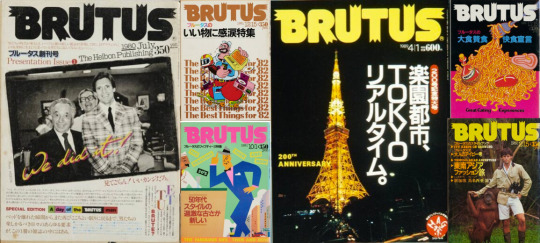
Popeye’s Revolution (Part 1)
Popeye’s Revolution (Part 2)
In 1980, four years after the explosive launch of "Popeye," Yoshihisa Kinameri and Jiro Ishikawa envisioned a new title for former readers who had outgrown the publication. They named it "Brutus," after the antagonistic character in the original Popeye cartoon.
Almost every long-lasting fashion/lifestyle title -- including Popeye -- underwent style and format changes through the years. But, throughout its five decades, Brutus' original concept remains the same, down to its bi-weekly periodicity. It's one of the most consistent success stories in Japanese fashion/lifestyle publishing history.
Throughout its four decades, Brutus became a guide to society's aspirations while reflecting the reality of the magazine business. In this post, we will focus specifically on Brutus' first decade.

With legendary designer Seiichi Horiuchi serving as its first art director, Brutus -- much like Popeye and AnAn -- quickly became a reference for its high-quality, creative magazine design.
Brutus' target is "males in their 30s," and each issue focuses on a specific theme. Still, the magazine appeals to men and women of all ages interested in sophistication and the particular issue's theme.
The publication was launched when Japan was rising to become a global superpower. Its first decade was highly prosperous, encompassing most of the miraculous "Bubble years" of the Japanese economy. This background helps explain some of the classic themes in the magazine, which are still present to this day: high-quality fashion, food, and alcohol.
Looking at 80s issues, we can identify plenty of subjects still part of present Brutus, like culture, travel, and city life. Others, like the coverage of certain sports (sailing/America's Cup; Formula 1) or the focus on cars and motorcycles, were indicative of specific 80s/early 90s trends.
Early Brutus was a snapshot of a country bustling with energy, money, and optimism.
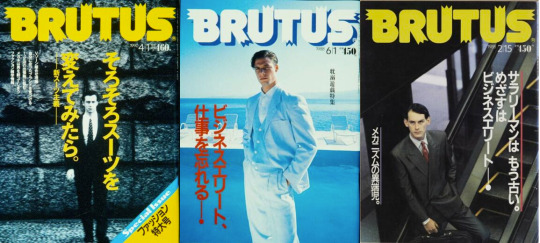
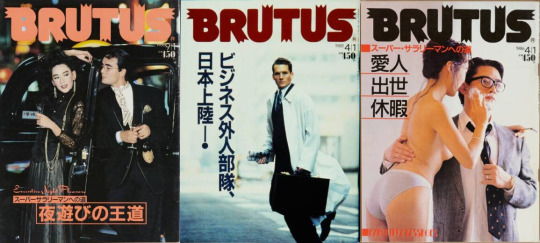
Brutus was originally a magazine for the post-Popeye generation: men who had graduated college and were now part of the workforce, a.k.a. "salarymen." The depiction of salarymen often has a depressing tone: faceless men in dark suits, overworked in bureaucratic, boring jobs, passed out on trains from exhaustion or drinking too much to cope with their burdening responsibilities. Not in early Brutus, where the portrayal of salarymen resembled how female fashion magazines characterize office ladies: young workers who should use their hard-earned financial independence to have fun and enjoy life.
With the bubble years as the backdrop, BRUTUS could convincingly sell the "salarymen" life as glamorous and a path to affluence. It told its readers to invest in expensive, glamorous suits; use their salary in fun ways, and leave the "salarymen" mindset behind, aiming instead to become a "business elite." A very 80s, optimistic way to see your career prospects, which would be much less convincing nowadays.


With the very generous budgets of the Bubble period, the magazine was known for travel-themed editions. The editors and the young staff would go on long trips to destinations perceived as "exotic" -- Africa, Vietnam, Thailand, China, South America, Cuba, Mexico -- and produce an entire issue around it.


Europe was also a popular destination for Brutus, with several issues exploring the continent and its culture. Decades before Scandinavian minimalism went mainstream, Brutus had an issue dedicated to the region's charms. Brutus highlighted East and West German culture. There were issues about traveling to Spain and Portugal, England, French culture and fashion…

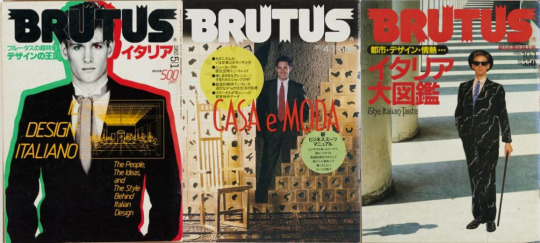
But 80s Brutus had a particular obsession with Italy. Italian fashion, Italian "dolce vita," Italian cuisine, Italian design, and the charm and style of Italian men were thoroughly examined by the magazine.


US culture was the basis for Popeye. And while Brutus preferred to explore Europe in its first decade, it also had several issues dedicated to American culture and travel tips. Some of the themes were very "bubble year 80s," such as an issue advising readers to go skiing in Texas and another centered on buying real estate in Hawaii.
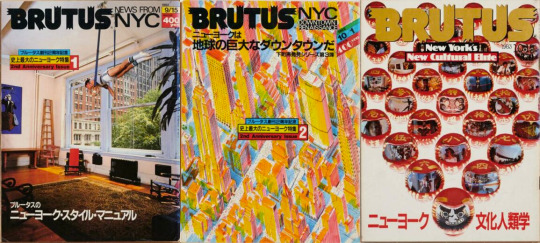

While the US often took a backseat to Europe, Brutus' favorite international city was New York City, as crystalized by two special mega-issues in 1982.

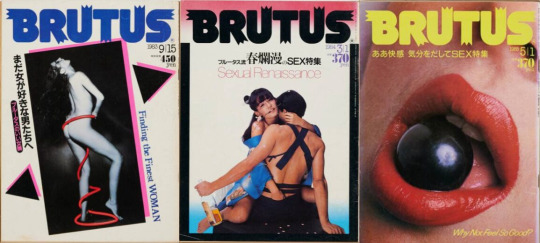
Popeye and Brutus explored many similar subjects: traveling, fashion, Tokyo city life, and where and what to buy. But 80s Brutus had something Popeye initially didn't: sex. A subject that completely matched Brutus's "pleasures of life" concept.
While "Hot Dog Press" had love manuals and sex guides for young teen boys (crucial for the magazine to surpass Popeye's sales), Brutus packaged that content in a more sophisticated, adult way. During the 80s, there were eight sex issues.
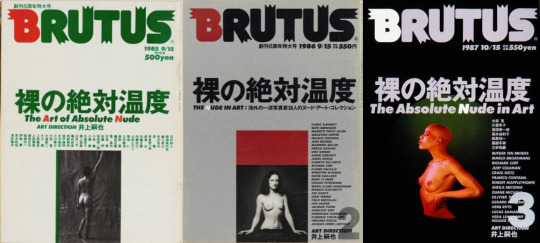

Regarding nudity, the 80s were very permissive compared to today's standards. While artistic shots of topless women on a magazine cover are unimaginable in 2022, '80s Brutus had several covers depicting nudity. In fact, its fifth-anniversary issue invited famed photographers to shoot nude pictorials. The edition was a hit, and the theme was repeated in other issues in the following years.


Brutus also had annual issues dedicated to architecture and interior design. It became such a standard Brutus topic that, in 1998, it spawned a spin-off title, "Casa Brutus."
But we're getting a little ahead of ourselves here. Going back to the 80s, it was the decade when the Popeye family grew exponentially.
One of the goals of Popeye magazine was to introduce Japanese youth to a more health-conscious lifestyle inspired by America. Besides sports, such as frisbee, skateboarding, and jogging, Popeye editors were fascinated by a concept that was somewhat foreign to Japan: muscle training. From the initial issue, the publication ran features on how to "shape up." Soon, Jiro Ishikawa started using another fictional character name to define the prototype of a muscular, fit guy: Tarzan.
The Tarzan lifestyle was particularly prominent in BRUTUS.

In 1985, for example, BRUTUS had an issue dedicated to the new "Tarzan era." Then, a few months later, in 1986, Tarzan became bi-weekly muscle training and fitness magazine, with Ishikawa as the founding editor. The first cover was shot by famed American photographer Reid Miles.
"Tarzan" is still in publication and is Japan's leading fitness publication.
But, of course, the Popeye family wouldn't be complete without Olive.
Olive magazine, aimed at the female public, was launched in 1982 as the "magazine for city girls." But it became a social phenomenon the following year when a female editor-in-chief took over and changed its entire concept. It wasn't solely the "female version of Popeye," but its own magazine, with a different vision: a dreamy, girly-like visual book aimed at teen girls. The "magazine for romantic girls" and its "lyceene" fashion were so influential that they'll be the theme of a future post. Despite its success in the 80s and 90s, "Olive" folded in 2000, the only one of the four spin-off titles that are not in circulation anymore.
20 notes
·
View notes
Text
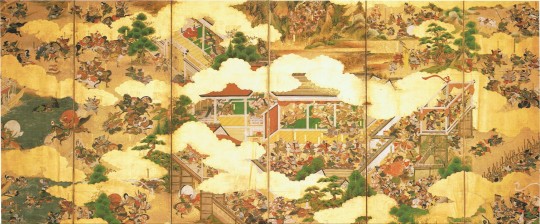
THE GENPEI WAR: RISE OF THE SAMURAI.
The Genpei War, a pivotal chapter in Japanese history, didn't erupt overnight. It was the culmination of a complex and tumultuous political landscape in late Heian Japan. To truly appreciate the significance of this conflict, let's journey back in time and explore the intricate web of political rivalries, power struggles, and events that led to the outbreak of the Genpei War.
In the late 11th and 12th centuries, the Japanese Imperial Court held a prestigious but largely symbolic role. True political power had shifted into the hands of provincial warriors, the samurai, leaving the Imperial Court weakened and divided by factionalism.
One of the dominant factions in this era was the Taira clan, led by the influential Taira Kiyomori. Kiyomori's rise to power was marked by cunning political maneuvering and the placement of loyal Taira members in key government positions.
Rivaling the Taira were the Minamoto, led by the ambitious Minamoto Yoritomo. They sought to challenge Taira's supremacy and establish their own influence within the Imperial Court.
Both Taira and Minamoto clans manipulated the Imperial Court in their favor. Behind-the-scenes maneuvering and political intrigue became commonplace as they vied for control and influence.
The spark that ignited the Genpei War was the dispute over the imperial succession. When Emperor Takakura passed away in 1180, two potential heirs emerged, each backed by a different faction. Emperor Antoku, supported by the Taira, and Emperor Go-Toba, supported by the Minamoto, became pawns in this high-stakes power struggle.
Adding fuel to the fire were local disputes and conflicts over territories and resources, further destabilizing the already fragile political landscape.
The Genpei War was not merely a clash of armies; it was a culmination of years of political maneuvering, deep-seated rivalries, and power struggles that transformed Japan forever.
In the coming posts, we will journey deeper into the heart of this conflict, exploring its major battles, key figures, and its profound impact on Japanese society and governance.
Stay tuned as we unravel the epic saga of The Genpei War, one of the most transformative chapters in Japan's history!
References:
"Samurai: The Making of Japan's Warrior Elite" by Karl F. Friday
"The Tale of the Heike" translated by Helen Craig McCullough
"The Cambridge History of Japan, Volume 2: Heian Japan" edited by Donald H. Shively and William H. McCullough
"Warriors of Japan: As Portrayed in the War Tales" by Paul Varley
"A History of Japan: From Stone Age to Superpower" by Kenneth G. Hensha
"War and State Formation in Ancient China and Early Modern Europe" by Victoria Tin-bor Hui
#GenpeiWarSamuraiHistoryJapaneseHistoryMedievalJapanHeianEraTairaClanMinamotoClanWarriorCultureHistoricalConflictFeudalJapan#genpeiwar#samurai#japan#history#heian era#heian period#bushido
2 notes
·
View notes
Text
2022-Shinzo Abe
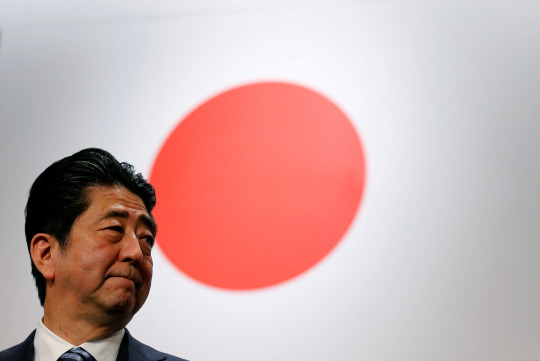
Shinzo Abe (/ˈʃɪnzoʊ ˈɑːbeɪ/SHIN-zoh AH-bay; Japanese: 安倍 晋三, Hepburn: Abe Shinzō, IPA: [abe ɕindzoː]; 21 September 1954 – 8 July 2022) was a Japanese politician and statesman who served as Prime Minister of Japan and President of the Liberal Democratic Party (LDP) from 2006 to 2007 and again from 2012 to 2020. He was the longest-serving prime minister in Japanese history, serving for almost nine years in total. Abe also served as Chief Cabinet Secretary from 2005 to 2006 under Junichiro Koizumi and was briefly the opposition leader in 2012.
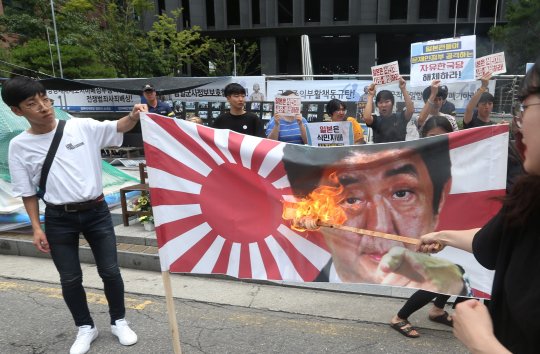
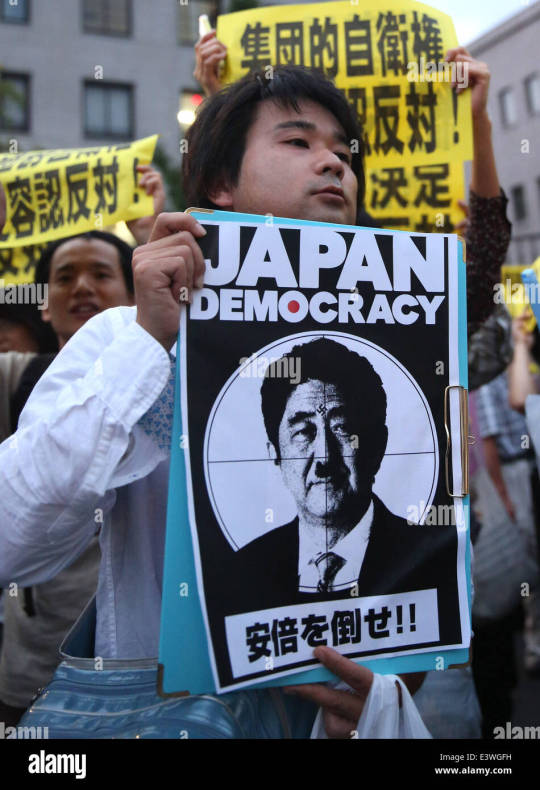
Abe was a staunch conservative whom political commentators had described as a right-wing Japanese nationalist. Associated with the Nippon Kaigi, he held negationist views on Japanese history, including denying the role of government coercion in the recruitment of comfort women during World War II, a position which caused tensions particularly with South Korea. Under his premiership, relations further strained in 2019 over disputes about reparations. Earlier that same year, Abe's government initiated a trade dispute with South Korea after the South Korean Supreme Court ruled that reparations be made by Japanese companies who had benefited from forced labor. Abe was considered a hard-liner with respect to Japan's military policies.
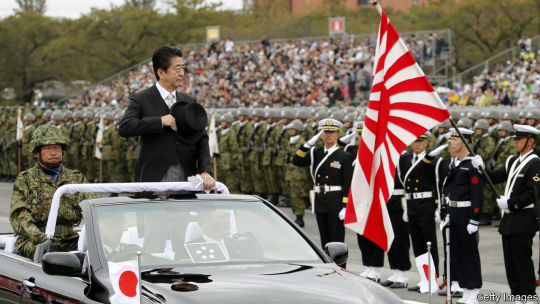
In 2007, he initiated the Quadrilateral Security Dialogue during his first tenure as prime minister, aimed at resisting China's rise as a superpower. He advocated for amending Article 9 of the Japanese Constitution to legally codify the status of the Japan Self-Defense Forces (JSDF), however this was never achieved during his lifetime. He enacted military reforms in 2015 that allowed Japan to exercise collective security by allowing JSDF deployments overseas, the passage of which was controversial and met with protests. Economically, Abe attempted to counter Japan's economic stagnation with "Abenomics", with mixed results. He was also credited with reinstating the Trans-Pacific Partnership with the Comprehensive and Progressive Agreement for Trans-Pacific Partnership.


Abe was assassinated on 8 July 2022 while delivering a campaign speech in Nara two days before the 10 July upper house elections. The suspect, who was immediately arrested by police, confessed to targeting the former prime minister because of Abe's alleged ties with the Unification Church. This was the first assassination of a former Japanese prime minister since 1936. A polarizing figure in Japanese politics, Abe was described by his supporters as having worked to strengthen Japan's security and international stature, while his opponents described his nationalistic policies and negationist views on history as threatening Japanese pacifism and damaging relations with East Asian neighbors China and South Korea. Commentators have said that his legacy pushed Japan towards more proactive military spending, security, and economic policies.

#Jul.8.2022#date of death#安倍 晋三#Shinzo Abe#Japanese politician#Prime Minister of Japan#President of the Liberal Democratic Party#history today
3 notes
·
View notes
Text
[SCMP is Hong Kong Private Media]
Indonesia’s long-drawn-out presidential election process has officially entered its final stages, with some of the country’s biggest political names formally submitting their nomination papers and launching their policy platforms.
Ahead of the opening of the nomination process, much of the national intrigue involved the identity of the running mate for Prabowo Subianto, current President Joko Widodo’s former rival-turned-ally. As long speculated, the 72-year-old defence minister revealed last weekend that his running mate would be Gibran Rakabuming Raka, Widodo’s 36-year-old son and mayor of the city of Solo.
Speculation has also swirled around who would get the outgoing president’s stamp of approval: Prabowo or former Central Java governor Ganjar Pranowo. Pranowo, 54, leads the ticket for Widodo’s ruling Indonesian Democratic Party of Struggle, alongside his vice-presidential candidate Mohammad Mahfud, 66, the outgoing coordinating minister of political, legal and security affairs.
Rounding out the list of candidates is Anies Baswedan – like Widodo, a former governor of Jakarta – and Muhaimin Iskandar, 57, deputy speaker of the House of Representatives. Supported by a coalition of parties named the Coalition of Change for Unity, the 54-year-old Anies has styled himself as the antithesis of Widodo, who is constitutionally barred from running for a third term.[...]
All three candidates have vowed to maintain Indonesia’s long-standing commitment to a neutral and non-aligned foreign policy, while also being active on the international stage to champion world peace – including by advocating for Palestinians amid the ongoing Israel-Gaza war, with Prabowo going the furthest in this regard by saying he would push to open an Indonesian consulate in Palestinian territory if elected.[...]
“Anies and Muhaimin will tend to be more critical of China in terms of maritime territorial integrity,” said Ahmad Rizky, an associate lecturer and researcher at the University of Queensland’s School of Political Science and International Studies in Australia. “But I am not sure that Anies will eliminate the engagement with China that Jokowi has been doing so far.”
Anies, who has trailed in opinion polls in recent months, said in his manifesto that he aims to “position Indonesia as a balancing force in the global order” so that the country can “prevent the domination of certain powers”, which Ahmad interpreted as a criticism of China’s rising assertiveness.
Prabowo [...] has been the most explicit when it comes to addressing fraught geopolitics, underlining that a major strategic challenge for Indonesia would be “rivalry between the two superpowers over Taiwan that could threaten the smooth supply chain of food, energy and trade” that passes through the Malacca Strait and North Natuna Sea.
The former special forces commander, who is making a third tilt at the presidency having twice lost to Widodo in 2014 and 2019, has pledged to “restore Indonesia’s foreign political authority as a large and sovereign country in the eyes of the international community”.
Twice last month, Prabowo made speeches warning against foreign influence, telling an audience of students at Muhammadiyah University in Malang, East Java on September 27 about Indonesia’s long history of colonisation and exploitation, and cautioning that the country should never again become “a puppet” of outsiders.
In another speech just a few days later, [Prabowo] again warned Indonesians not to become “the playthings of major powers” who “clearly set forth a strategy of divide and conquer”.
In past elections, [Prabowo,] the former son-in-law of late strongman president Suharto [and son of a major state economist in the Suharto government] had held the establishment responsible for society’s ills, but [an analyst] said this tactic would no longer work, as Prabowo was stripped of his opposition credentials when Widodo made him defence minister in 2019.[...]
“He wants Indonesia to engage with all major powers, not just the US and China,” Ahmad said, adding that the outgoing defence chief would “want Indonesia to play a bigger role outside of the context of [ASEAN] regionalism” and also “change his stance to no longer being anti-China”.
“He would want to encourage stronger engagement with China, something that he has already done in a diplomatic and defence context,” Ahmad said, further predicting that “Prabowo could tend to be closer militarily to the US”.[...]
[Prabowo] has led efforts to overhaul Indonesia’s ageing air fleet – mainly US-made F-16 and Russian Sukhoi Su-27 and Su-30 jets – securing a deal in February to order 42 Dassault Rafale fighter jets from France for US$8.1 billion; confirming in June the purchase of 12 Mirage 2000-5 jets previously used by Qatar for US$800 million; and in August signing a deal with Boeing for 24 F-15EX aircraft, the most advanced version of the US company’s F-15 jet, for an undisclosed amount.
Anies and Ganjar have likewise committed to modernising Indonesia’s military, with the former focusing in his manifesto on upgrading the country’s coastguard and protection of outlying islands.
Ganjar, meanwhile, outlines in his campaign manifesto Towards a Superior Indonesia a plan to introduce anti-access and area denial weapons and strategies – which can span missiles, electronic warfare, mines, aircraft and coastal artillery – “to secure territorial sovereignty and the implementation of sovereign rights” in the country’s exclusive economic zone.[...]
Ganjar was essentially signalling that the US and China should “not use Indonesian waters for their military interest” [according to an analyst][...]
All candidates have said they would uphold Widodo’s flagship “downstreaming” policy, whereby exports of critical raw minerals such as nickel are banned and producers are required to build refining facilities onshore, with Prabowo even vowing to widen it further to include “copper, tin, agriculture products and maritime products”.
Yet Sulfikar Amir, an industry, innovation, and technology spokesman for Anies’ campaign, said under his candidate “there will be a ban on commodity exports, but it will not repeat the current downstreaming order”.
As it stands, downstreaming “basically gives away our materials to foreign investors who come to build processing facilities in Indonesia and ultimately export them,” [Sulfikar] said. “Ultimately the ones who enjoy the [added] values are foreign investors.”[...]
The spokesman added that Anies would also not prioritise another of Widodo’s big-ticket projects: moving the country’s capital away from Jakarta to the new city of Nusantara being built on the island of Borneo.[...]
Ganjar, by contrast, said he aims to complete the new capital’s construction if elected, calling it “a symbol of futuristic Indonesia”.[...]
Anies took a stronger line, openly criticising Widodo’s dealings with foreign investors, particularly within the context of the Belt and Road Initiative and other multilateral economic forums.[...]
Belt and road projects offer “benefits for Indonesia, we cannot deny it,” Sulfikar [Anies’ campaign spokesman] said. “But the scheme and relationship between Indonesia and [the initiative] needs to be reviewed so that we would not deeply depend on [Chinese investments] that could harm Indonesia in the long term.”
“Look at the [Jakarta-Bandung] fast train [project]. Indonesia has to go into debt because the project is delayed. So everything [agreed under the belt and road] will be reviewed.”
27 Oct 23
17 notes
·
View notes
Text
This day in history

#20yrsago Bruce Sterling on Total Information Awareness https://www.wired.com/2003/04/i-want-my-tia/?pg=4
#20yrsago Chinese state sends 20m SMS messages to crush SARS rumor https://web.archive.org/web/20030618180119/http://www.guardian.co.uk/online/news/0,12597,928906,00.html
#20yrsago Found poetry from Rumsfeld’s speeches https://web.archive.org/web/20030415133226/http://slate.msn.com/id/2081042/
#20yrsago OS X floppy disk RAID https://web.archive.org/web/20030601111810/http://ohlssonvox.8k.com/fdd_raid.htm
#15yrsago Best practices for water imbibing: “Just drink when you’re thirsty” https://www.npr.org/2008/04/03/89323934/five-myths-about-drinking-water
#15yrsago Debating the feasibility of an in-flight liquid bomb https://www.schneier.com/blog/archives/2008/04/the_liquid_bomb.html
#15yrsago Boston judge: making files available to download isn’t piracy https://www.eff.org/deeplinks/2008/04/making-available-distribution-says-court-london-sire-v-doe
#15yrsago Air Canada: for $35, we’ll let you talk to customer-service reps who can actually help you with a cancelled flight https://www.thestar.com/business/2008/04/03/air_canada_to_charge_for_customer_service.html
#15yrsago Japanese creative packaging design solutions to ugly barcodes https://www.darkroastedblend.com/2008/04/japanese-creative-barcodes.html
#15yrsago Charles Manson uses Creative Commons licenses https://web.archive.org/web/20080403104925/http://blog.limewire.com/posts/1616-Even-Charles-Manson-Digs-Creative-Commons
#15yrsago China’s instant cities — jaw-dropping National Geo feature https://web.archive.org/web/20080402102202/http://ngm.nationalgeographic.com/ngm/0706/feature4/index.html
#15yrsago Banks refuse to take title on repossessed crappy houses https://web.archive.org/web/20080406130131/http://bigpicture.typepad.com/comments/2008/04/the-advantages.html
#10yrsago Iain Banks: I’m dying of cancer, this book will be my last https://www.theguardian.com/books/2013/apr/03/iain-banks-gall-bladder-cancer
#10yrsago Podcast to mark centennial of Marc Davis, co-creator of Haunted Mansion, Pirates of the Caribbean https://mousetalgia.libsyn.com/remembering-marc-davis-with-alice-davis
#10yrsago Autonomous sensory meridian response — self-diagnosed neurological condition/superpower that makes you really enjoy whispering https://www.independent.co.uk/tech/maria-spends-20-minutes-folding-towels-why-millions-are-mesmerised-by-asmr-videos-7956866.html
#10yrsago Queen goes on austerity footing, receives mere £5M pay-rise from the taxpayers https://www.theguardian.com/uk/2013/apr/02/queen-gets-5m-payrise-taxpayer
#5yrsago Offering users transparency and privacy is the only way Big Tech can avoid being turned into content cops https://dangillmor.medium.com/why-tech-platforms-should-give-users-more-control-and-how-they-can-do-it-6c6c48ab90c0
#5yrsago The technologies that would make the web more participatory https://medium.com/@anildash/the-missing-building-blocks-of-the-web-3fa490ae5cbc
#5yrsago Eight months ago, Panera Bread was warned that they were leaking up to 7 million customers’ data. They fixed it yesterday. Kinda. https://krebsonsecurity.com/2018/04/panerabread-com-leaks-millions-of-customer-records/
#5yrsago Even the telco industry thinks Ajit Pai is an asshole for maiming Lifeline, a broadband subsidy for poor Americans https://www.techdirt.com/2018/04/03/fcc-boss-under-fire-facts-optional-attack-low-income-broadband-programs/
#5yrsago Analysis of all the elections since Trump produces no clear answers on the class and suburban/urban correlates of flippability https://fivethirtyeight.com/features/be-skeptical-of-anyone-who-tells-you-they-know-how-democrats-can-win-in-november/
#5yrsago Alex Jones falsely accused a guy of being the Parkland school shooter, so now he’s being sued for more than $1,000,000 https://www.thedailybeast.com/falsely-accused-parkland-school-shooter-sues-alex-jones-infowars-for-defamation/
#5yrsago 2018 tsunami: Teachers lead mass strikes in four red states that voted for Trump in 2016 https://thehill.com/homenews/state-watch/381307-teachers-flex-political-muscle-in-red-state-strikes/
#5yrsago The Manhattan property bubble is bursting https://www.ft.com/content/b0ab3fa6-36a7-11e8-8eee-e06bde01c544
6 notes
·
View notes
Photo
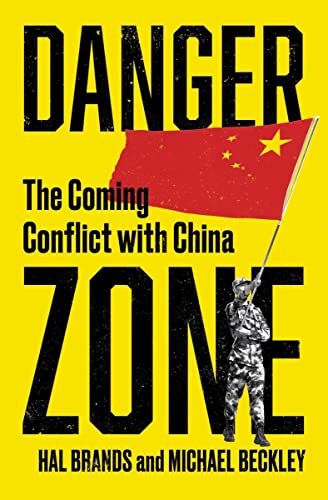
My favorite books in Feb-2023 - #6
Danger Zone: The Coming Conflict with China Hardcover – August 16, 2022 by Michael Beckley (Author), Hal Brands (Author)
A provocative and urgent analysis of the U.S.–China rivalry.
It has become conventional wisdom that America and China are running a “superpower marathon” that may last a century. Yet Hal Brands and Michael Beckley pose a counterintuitive question: What if the sharpest phase of that competition is more like a decade-long sprint?
The Sino-American contest is driven by clashing geopolitical interests and a stark ideological dispute over whether authoritarianism or democracy will dominate the 21st century. But both history and China’s current trajectory suggest that this rivalry will reach its moment of maximum danger in the 2020s.
China is at a perilous moment: strong enough to violently challenge the existing order, yet losing confidence that time is on its side. Numerous examples from antiquity to the present show that rising powers become most aggressive when their fortunes fade, their difficulties multiply, and they realize they must achieve their ambitions now or miss the chance to do so forever. China has already started down this path. Witness its aggression toward Taiwan, its record-breaking military buildup, and its efforts to dominate the critical technologies that will shape the world’s future.
Over the long run, the Chinese challenge will most likely prove more manageable than many pessimists currently believe―but during the 2020s, the pace of Sino-American conflict will accelerate, and the prospect of war will be frighteningly real. America, Brands and Beckley argue, will still need a sustainable approach to winning a protracted global competition. But first, it needs a near-term strategy for navigating the danger zone ahead.
2 notes
·
View notes
Text
The war in Ukraine may have many positive outcomes: a Russia bled white by its own aggression, a United States that has rediscovered the centrality of its power and leadership, a democratic community that has been unified and energized for the dangerous years ahead. There will also be one very ominous outcome: the rise of a coalition of Eurasian autocracies linked by geographic proximity to one another and geopolitical hostility to the West. As Russian President Vladimir Putin’s folly rallies the advanced democracies, it hastens the construction of a Fortress Eurasia, manned by the free world’s enemies.
Revisionist autocracies—China, Russia, Iran, and, to a lesser degree, North Korea—aren’t simply pushing for power in their respective regions. They are forming interlocking strategic partnerships across the world’s largest landmass, and they are fostering trade and transportation networks beyond the reach of the U.S. dollar and the U.S. Navy. This isn’t, yet, a full-blown alliance of autocracies. It is, however, a bloc of adversaries more cohesive and dangerous than anything the United States has faced in decades.
All the great conflicts of the modern era have been contests over Eurasia, where dueling coalitions have clashed for dominance of that supercontinent and its surrounding oceans. Indeed, the American Century has been the Eurasian Century: Washington’s vital task as a superpower has been keeping the world in balance by keeping Eurasia divided. Now the United States is again leading a coalition of democratic allies on Eurasia’s margins against a group of centrally located rivals—while crucial swing states maneuver for advantage.
Countries such as Turkey, Saudi Arabia, and India have a critical role in this era of rivalry, thanks to the geography they occupy and the clout they wield. In many cases, these powers are determined to play both sides. Containing the Eurasian challenge will involve strengthening the bonds within and between the United States’ alliance networks. Yet what makes the current moment so daunting is that opportunistic swing states will also shape the fight between Fortress Eurasia and the free world.
Eurasia has long been the world’s key strategic shatter zone because it is where the richest and most powerful countries—the United States excepted—are located. And since the early 20th century, this sprawling supercontinent has seen vicious brawls for geopolitical primacy.
In World War I, Germany sought an empire from the English Channel to the Caucasus; it took a trans-Atlantic coalition of democracies to beat the challenge back. In World War II, Germany and Japan conquered Eurasia’s vibrant rimlands and drove deep into its heartland; an even grander, more ideologically diverse coalition rallied to restore the balance. In the Cold War, a centrally located superpower, the Soviet Union, tried to overawe a free-world coalition on Eurasia’s margins. The specifics change, but the basic clash—between those who seek to rule Eurasia and those, including the overseas superpower, who oppose them—endures.
After their Cold War victory, Washington and its friends were preeminent in all of Eurasia’s key subregions: Europe, East Asia, and the Middle East. Yet challenges have since reemerged from rivals that have increasingly coalesced around their shared hostility to the status quo. And just as major crises often speed up history, the Russia-Ukraine war is accelerating the rise of a new Eurasian bloc.
Putin’s invasion of Ukraine was a bid to remake Eurasia by force. If Russia had conquered Ukraine, it could have restored the European core of the old Soviet Union. Moscow would have had a commanding position from Central Asia to NATO’s eastern front. The Sino-Russian strategic partnership would have seemed ascendant, while the democracies suffered another demoralizing defeat. That scenario unraveled with Putin’s shambolic offensive. Yet the war has still had profoundly polarizing effects.
It has undoubtedly galvanized the advanced democracies. NATO is rearming and expanding. Democracies in Asia have supported Ukraine and sanctioned Russia for fear that successful aggression in one region may encourage deadly adventures in others. Countries linked by liberal values and support for the U.S.-led international order are strengthening their defenses from Eastern Europe to the Western Pacific, and they are rethinking economic and technological ties to the tyrannies in Moscow and Beijing. What U.S. President Joe Biden calls the “free world” is again taking shape. So, unfortunately, is an autocratic coalition.
Moscow, Beijing, Tehran, and Pyongyang all seek to overturn the balance of power in their regions and view Washington as the primary obstacle. All worry about their vulnerability to sanctions and other punishments the United States and its global posse can impose. All need the others to survive because if the United States and its allies destroy any one of them, the remainder become more isolated and vulnerable. Finally, all are located within Eurasia and enjoy proximity, if not contiguity, with at least one other revisionist state. As the Russia-Ukraine war heightens global tensions, these autocracies are drawing together, for self-protection and strategic profit.
This trend isn’t new, of course. Iran and North Korea have long shared missile technology and other means of mischief; the Sino-Russian strategic partnership has been developing for decades. But if the war has strained that partnership, it has also underscored the convergent aims and anxieties of the revisionists. It has thus accelerated integration at the world’s Eurasian core.
A Eurasian bloc is cohering militarily, as the war fosters overlapping and increasingly ambitious defense ties. Russia’s military relationship with North Korea has become a two-way street, as Pyongyang sells Moscow badly needed artillery ammunition. Russia and Iran, meanwhile, are building what CIA Director William Burns calls a “full-fledged defense partnership.” That partnership involves transfers of drones, artillery, and, reportedly, missiles that have strengthened Russia on battlefields in Ukraine; it may presage the transfer of advanced Su-35 fighter aircraft, air defense systems, or ballistic missile technology, which would make Tehran a tougher enemy for the United States and Israel.
China, for its part, hasn’t openly supported Putin’s war with lethal military aid, for fear of U.S. and European sanctions. It has, however, provided so-called nonlethal assistance—from drones to computer chips—that helps Putin protract his fight, and Beijing would probably go further if its most important ally were facing defeat. For now, the conspicuous presence of Chinese President Xi Jinping’s defense experts during his recent summit with Putin in Moscow signaled that the larger military relationship—which already features joint exercises, arms sales, and significant technological cooperation—continues to race past the limits many Western observers expected a decade ago.
It wouldn’t take a formal Sino-Russian alliance to upend the military balance. If Russia provides China with sensitive submarine-quieting technology or surface-to-air missiles, it could profoundly change the complexion of a Sino-American war in the Western Pacific. In today’s Eurasia, well-armed revisionists are making common cause.
They are also restructuring international trade. Commerce, or weapons shipments, that traverses Eurasia’s marginal seas can be seized by globe-ranging navies. Dollar-dependent economies are vulnerable to U.S. sanctions. A second aspect of Fortress Eurasia, then, involves building trade and transportation networks safe from democratic interdiction.
For years, China has invested in overland pipelines and railroads meant to ensure access to Middle Eastern oil and other crucial resources. Beijing is now seeking to sanction-proof its economy by reducing reliance on foreign inputs, a project that has gained urgency thanks to the Western economic war on Moscow. Russia and Iran are energizing the International North-South Transport Corridor, which connects the two countries via the land-locked Caspian Sea, as Tehran instructs Moscow in sanctions evasion. Likewise, Russia and China are deepening cooperation to develop the Northern Sea Route, the least vulnerable maritime path between China’s Pacific ports and European Russia. When “international trade is in crisis,” as Putin said euphemistically last November, Eurasian integration is essential.
Indeed, Russia-Iran trade has spiked since February 2022, while China has become Moscow’s key commercial partner “by a wide margin,” as the Free Russia Foundation reports. Bilateral trade in Russian oil and Chinese computer chips is surging; Russian firms are turning to Hong Kong to raise capital while skirting sanctions. And as Chinese technology spreads throughout Eurasia, its currency proliferates, too.
This February, the yuan overtook the dollar as the most traded currency on the Moscow Exchange. China and Iran are also experimenting with cutting the dollar out of bilateral trade. “Geopolitics will not, of course, lead to the global dethronement of the dollar” anytime soon, Alexander Gabuev, the director of the new Carnegie Russia Eurasia Center in Berlin, wrote in Bloomberg in March. But it could promote a Sino-centric economic and technological bloc at the heart of the Old World.
Finally, this Eurasian bloc is cohering intellectually and ideologically. The Sino-Russian joint statement in February 2022 portrayed the two countries as defending their autocratic political systems while resisting the United States’ Cold War-style alliance blocs. Iranian officials describe Eurasian cooperation as the antidote to U.S. “unilateralism”; Putin deems Eurasia a haven for “traditional values” besieged by Western “neoliberal elites.” Because the current war has severed Putin from the West, it has also resolved Russia’s perennial debate about which direction to face. For the time being, Russia’s destiny is Eurasian.
To be sure, there are limits. Whatever Putin says, the North-South corridor will never put the Suez Canal to shame. A globally integrated China won’t have to go all-in on Eurasia as a more isolated Russia must. Tensions lurk within the league of autocracies: Some Russian nationalists, if not Putin himself, must worry that a Eurasian orientation ultimately means economic vassalage to Beijing. In the meantime, however, Fortress Eurasia will make life much harder for Washington and its friends.
Eurasian integration will also make the United States’ antagonists less vulnerable to sanctions. It will strengthen them militarily against their foes. It will lead to wide-ranging diplomatic cooperation—such as stronger Russian support for China’s position on Taiwan—or perhaps even material assistance to one another in a war against the United States. If Russia had the opportunity to help China bleed the United States in a fight in East Asia, does anyone doubt it would have the motivation?
Even short of that, Fortress Eurasia will make the world safer for violent revisionism. The more secure these countries feel in their Eurasian stronghold, the more support they have from one another, the more emboldened they will be to project power into peripheral regions—the Western Pacific, Europe, the Middle East—and beyond.
Biden isn’t wrong, then, in describing a great struggle “between democracy and autocracy, between liberty and repression, between a rules-based order and one governed by brute force.” Yet this binary doesn’t fully capture the Eurasian landscape. The Russia-Ukraine war has also underscored the importance of strategically located swing states, which seek advantage from both Fortress Eurasia and the free world and affect the balance between the two.
In the Persian Gulf, a resource-rich region at the crossroads of three continents, longtime U.S. security partners now deem monogamy less rewarding than polyamory. Saudi Arabia and the United Arab Emirates are shifting, economically and technologically, toward China. Both keep strong ties with Russia, even amid its war in Ukraine. Anti-communism once provided ideological glue in these monarchies’ relations with Washington. Today, however, modernizing autocracies have more in common politically with the United States’ rivals than with the United States itself.
To the West, Turkey occupies the intersection of two seas and two continents, and Turkish President Recep Tayyip Erdogan is, likewise, playing a double game. Ankara enjoys NATO’s protection while importing Russian air defenses; it supports Ukraine while helping Moscow to evade sanctions; and it has become a key player in conflicts from the Caucasus to the Horn of Africa, often in opposition to U.S. interests. How Turkey aligns, in other words, varies from issue to issue. And so long as an ambitious, increasingly illiberal Erdogan rules, it will aim, as Turkish analyst Asli Aydintasbas wrote in Foreign Affairs in 2021, “to keep a foot in each camp.”
Then there is South Asia. Pakistan, once a critical U.S. partner, now leans toward Beijing, which sees it as a conduit to the Indian Ocean. India, conversely, is tilting toward Washington for protection against China. But it still relies on Russia for arms and energy, and ideology and self-interest make India more comfortable navigating between the great powers than tying itself to any of them. It is a mistake to think New Delhi has irrevocably made its choice: At some point, Prime Minister Narendra Modi might welcome détente with China were Beijing to relax the pressure along the countries’ shared frontier. And in other countries around the Eurasian periphery, from Indonesia to Egypt, alignments are more fluid still.
The swing states are diverse, but the commonalities are striking. None are among the rich, economically advanced democracies. All prefer to maneuver between rival coalitions, in hopes of keeping options open and eliciting the best possible deals from each. All have been ambivalent, at best, in responding to Putin’s invasion of Ukraine because they value their relationships with Moscow and worry that polarized geopolitics will preclude diplomatic flexibility. And all can meaningfully affect the configuration of power around the world’s central landmass.
Each of these swing states has already bolstered Putin’s war in Ukraine, by helping him to reduce the impact of sanctions. Saudi Arabia did so most spectacularly in late 2022, via oil production cuts that sent prices—and Moscow’s revenues—higher. Their choices have other critical implications, as well.
The UAE may be moving toward hosting a Chinese base on its territory—and thereby helping Beijing to insert its military power in a sensitive region. Saudi Arabia has already welcomed Chinese diplomatic power into the Persian Gulf, relying on Beijing to broker a mini-détente with Tehran. In South Asia, a Pakistan closely bound to Beijing will make it far easier for China to escape its “Malacca dilemma”—the fact that much of its westward trade must pass through a narrow strait it does not control. India’s decisions will influence the global distribution of technological influence and manufacturing capacity—the latter being particularly essential as the threat of great-power war grows—as well as how much trouble China faces on land as it pushes outward at sea. Turkey’s choices will affect the level of economic pressure Putin faces, the strength and solidarity of NATO, and the geopolitical landscape from Central Asia to the Middle East.
The competition for the swing states isn’t merely some global popularity contest. It will help determine whether the defenses Washington must erect around Fortress Eurasia are strong or full of holes.
In 1944, Japan dispatched a submarine carrying gold, tungsten, and other materials to Nazi-occupied Europe. It was a suicide mission: After traveling thousands of miles around Asia and Africa, the submarine was sunk by U.S. aircraft near the Bay of Biscay. Berlin and Tokyo were fighting to remake the world, but the cruelties of geography made cooperation impossible.
Today’s revisionists don’t have this problem. The location of the Eurasian autocracies doesn’t simply make the new red blob look scary on a map. It helps them reduce asymmetric U.S. strengths and fight back-to-back against the outside world. As during the Cold War, a geographically dispersed free world confronts a geographically coherent coalition. Now as then, there is also a third group that can cast a swing vote in global affairs.
The United States can’t easily reverse the formation of Fortress Eurasia because that process is the result of strong shared interests and sharpening global tensions produced by the war in Ukraine. In theory, perhaps, Washington could split the coalition by reconciling with one or more of its members. In practice, if such reconciliation were possible, it would require concessions—abandoning Ukraine and parts of Eastern Europe to Moscow, for instance—that would worsen Washington’s global problems. What remains, then, is a twofold response.
The United States has alliance blocs that give it tremendous leverage in East Asia and Europe. In the aggregate, the United States and its treaty allies are mightier—economically, diplomatically, militarily—than their adversaries. So the first imperative is to strengthen the alliances that anchor Eurasia’s endangered margins while strengthening the bonds between them so aggression anywhere meets an increasingly global response.
To its credit, Washington is pursuing elements of this strategy—by tightening alliances with Japan and the Philippines, bolstering NATO’s eastern front, and crafting partnerships, such as AUKUS, that bind like-minded democracies across multiple regions. The next steps would be to further integrate free-world defenses where threats are most severe, perhaps by pursuing a trilateral U.S.-Japan-Australia commitment to resist Chinese aggression or by laying out serious plans for how European powers might respond, militarily or economically, to conflict in the Western Pacific. The difficulties here are hardly trivial, and a U.S. presidential election outcome in 2024 or after that would restore a unilateralist, America First administration could complicate matters further still. But, for the moment, the task is a familiar one of alliance management and fits comfortably within Biden’s free-world frame.
More conceptually challenging is the second imperative: maximizing strategic convergence with the swing states while minimizing divergence where it would hurt the most. Because these countries have good reasons for their ambivalence, this will be an arduous, often unsatisfying task.
It will require separating the essential from the important—namely, identifying those issues, such as keeping Chinese military bases out of the Persian Gulf, where the United States should aggressively employ its leverage to avert a meaningful change in the Eurasian equilibrium. The corollary involves accepting that moral compromises—and trade-offs between the short term and the long term—will be starker in dealing with swing states than in dealing with advanced democracies. The United States can make Saudi Arabia a pariah or directly challenge India on issues of domestic governance but not without jeopardizing cooperation on issues of strategic importance. This suggests that Washington should also tailor its message to its audience: Outside the global West, appeals to democratic norms will be less effective than an emphasis on sovereignty, territorial integrity, and other norms that are threatened by the behavior, as opposed to the regime type, of the revisionist quartet.
These points, in turn, underscore the frankly transactional nature of diplomacy with swing states. The U.S.-Saudi special relationship is history, and appeals to democratic solidarity won’t get Washington very far in New Delhi. The United States will have to buy cooperation from Saudi Arabia, India, and other players by offering benefits of real value while also withholding those benefits when swing states consistently conduct foreign policies contrary to important U.S. interests. If the United States regularly punishes swing states for their diplomatic choices, it risks turning ambivalence into hostility; if it never does so, it risks losing all leverage. Yet, because this is such a tricky balancing act, it is important, finally, to shift the underlying incentives over time.
By depleting the Russian defense industry, Putin’s war has created an opportunity to help Turkey, India, Vietnam, and other states move away from Moscow’s military gear—and thereby change their calculus on discrete geopolitical issues. Encouraging Indian economic ties with the Persian Gulf can, similarly, reduce reliance on Chinese trade and money in two important regions.
For the fourth time in little more than a century, an epic clash over Eurasia is underway. Winning it will require the United States to rally its free-world allies while also competing, imperfectly, to influence countries that won’t commit either way.
5 notes
·
View notes
Text
This has been brewing in my mind for the past like 5+ years, evolving and changing in the back of my head, but I think recently I finally found a way to express it...
The depiction of disability in a lot of media bothers me so much, and sometimes I see shades of it in this site too. The way that tools to aid physical disability, especially, are appreciated if they are 1) technologically advanced, be it a lot of moving mechanical pieces or with machinery, or 2) aesthetically pleasing, to the level of impractical showpieces. I do find both of them extremely cool-- that is, on a technical and aesthetic level. But this almost “veneration” for “cool ways to “”””counter”””” disability”, ie. “your disabled character should be cool to ‘offset’ their disability”, just feels like worms in my throat.
Let’s take adventure stories. You can have magic to make the fanciest of designs work, yes, but sometimes I feel like that’s another way to kind of bypass the actual uh, disability? Not in the sense that disabled people wouldn’t want to OR cannot want to fully recover a lost limb or regain full mobility, but that it’s the only way you can “rise above” your disability. Fully regaining the lost functionalities of your body. Be above it all.
But living with disability doesn’t mean that you’re somehow living a “lesser” life if you’re not equipped with state of the art myoelectric prosthetic limb; a lot of people without access to these more advanced prostheses live and are not languishing staring out the window longing for the sun or whatever. They have to find another way, yes, to accommodate their limitations. And that’s normal. What a grandma with a bad back can do is naturally different from what a 10 years old can do; that’s why grandmas make us put the thread through the needle eye. But we, hopefully, don’t see that as a lesser mode of living. They find workarounds, be it making use of otherwise useless tween grandchildren, or using that diamond shaped thingy. They won’t do it as fast as a 24 yo with normal eyesight but that’s a given.
And in that same way, I wish more authors actually write with their disabled characters in mind-- especially if said disabled character is part of the main cast. It’s not impossible to write a physically disabled character as part of an adventure novel cast, I promise. But you as the author, and by extension your other main characters, have to accommodate for them, too. Most of the time their limitations are something workable. Blind characters aren’t helpless, they don’t need to be superpowered to be a part of a mobile team either. I’ve read about this one team in the Philippines going on a hike up a mountain with visually-impaired youths. I was looking for a similar story specifically to write a blind character of mine, who, given the setting is ancient China, would have to navigate mountainous terrain. And from the blog post:
Unlike city sidewalks where you can predict the each step, in the mountains, every step is different: the terrain, the incline, and the many obstacles. But Jerald proved to be very intuitive in adjusting to the different kinds of trail we walked through, and as we went higher, I needed fewer words to guide him, allowing us to talk about other things.
[...]
Once, when we were resting on the trail, young Stephen correctly identified how many of us were there; and Jerald himself was very sensitive in detecting the subtle changes in the trail and in the weather. Having focused on our sense of sight, I guess we have not learned to develop our other senses to their fullest potential.
[..]
[...] and in the end we took just the same time it would have taken had we been guiding sighted hikers.
Any writer who can actually write and are dedicated to having their disabled character treated properly would be able to acknowledge the limitations and challenges the disability would impose, yet also figure out realistic workarounds. They don’t need to be able to run up and down a mountain without tripping to deserve a place in the team. Fuck, sighted people fucking trip all the goddamn time. Sighted people can have godawful balance and suck at hiking. They don’t need to be cool and “above it all” just to offset their blindness.
This need to make the character be “above the limitations of their disabilities” can also manifest in like, hyperadvanced prosthesis. Listen man, I’m a biomedical engineering major, I understand, possibly more than you do, how exciting it can be. Each and every advancement in the field both furthers the field of engineering and that of human body and medicine. HOWEVER. Something I realize over the years is that a lot of these cutting edge science... are not actually very useful to disabled people, and are unlikely to be for at least a decade or five.
Take, for example, myoelectric prostheses. I’ll be real with you: I love this field. It was actually the reason why I majored in biomedical engineering, and I’ve been thinking about going there since 8th grade. My thesis was focused on the electrode part of the prosthesis. But the goddamn thing is $18,703 for a hand. Up to the shoulder, it’s $100,000. That cost is unlikely to go down much in the coming years. This isn’t even accounting for possible surgery costs, because of course the most cutting-edge version would require surgery that moves your fucking arm nerves to your torso to make the prosthesis move to “thought”. This isn’t even accounting for maintenance, which would require engineers with very specific skillset, probably, and would only be available in big city centers no doubt. There might only be 1-2 centers in ENTIRE COUNTRIES, if any. Did I mention that the thing is heavy in an unnatural way, and the attachment to the stump can hurt after prolonged use?
I wish I still remember the link, but I’m reminded of an article I read somewhere back during my college days. It talks about this old man who lost part of his arm, below the elbow. He operated farm machinery as part of his daily life, and in the end the arm prosthesis he chose isn’t anything with “a hand shape at the end” of it-- it was something like a hook, I think, to interact with the machinery he uses. It requires no complex structure or body that demands high maintenance, nor does it need a specialized engineer to do so. It enables him to live his life as previous. Did his life change from the loss? Of course it does. Loss is loss-- it’s something he can’t get back. But managing lifelong disability, much like any other chronic illness, is less about becoming “perfectly whole again” and more about restoring day-to-day functional capability.
And circling back to the media depiction, because I’m incredibly disorganized-- it bothers me when disabilities are used to either: 1) highlight a character’s “soft/intellectual power”, as in using the physical frailty or disability to further accentuate the power of their mind, or 2) treating the disability as though it doesn’t exist at all functionally (blind characters navigating new locations perfectly, straight up forgetting they’re disabled sometimes, I SEE YOU AUTHORS DOING THIS), or 3) cool points. I will attack you on the streets if you do this, btw.
At the end of the day, all three ways of depicting disability is incredibly... dehumanizing. So many of us are fine with fictionally navigating the limitations of people with mental illnesses, or personalities like being prideful, having addictions, etc, and yet so few would spend the 5 minutes to think, “how is my blind character going to yanno, travel though the goddamn mountains in my wuxia?”
And that fucking bothers me.
2 notes
·
View notes
Text
Is he for real? #ello #shorts #dance #babydance #breakdance #pop
This kid is considered to be later on one of the most powerful super saiyan and rivaling the head super Saiyan when someone is playing and it's my part it's my character they're playing and I actually have to run him a little bit just like venom
Zues Hera
Yeah okay my name might be Goku and I'm the small kid with a monkey tail don't know where it comes from and he says it's probably comes from China that's very funny yes some kind of strange you Kay Jew it's kind of a closed society even to us sometimes he says and I agree but we know which one it is and it's terrifying and we do see what you're saying I'm going to have superpowers so I can become giant real quick and I can become a huge monkey oh my God I'm in the movie with Kong and I'm inside the monkey it's not really a monkey and here we go
He says it's a lower level demon that might get possessed we want to check out that cavern war and see what it is
Goku
That was great too Goku but it is past your bedtime and it's time to drink krillin's special drink and go to sleep and get some rest so we can get up tomorrow and be stronger
Gohan
And that's his character and what he sounds like with me I'm going to sleep and I have the special drink and I'll feel better in the morning and I really like it
Goku he says we're going to have a lot of noodles and soup and at the magical rise and we know what that means it's a special place you'll see the sunset rise along the palace silhouette
Olympus
0 notes